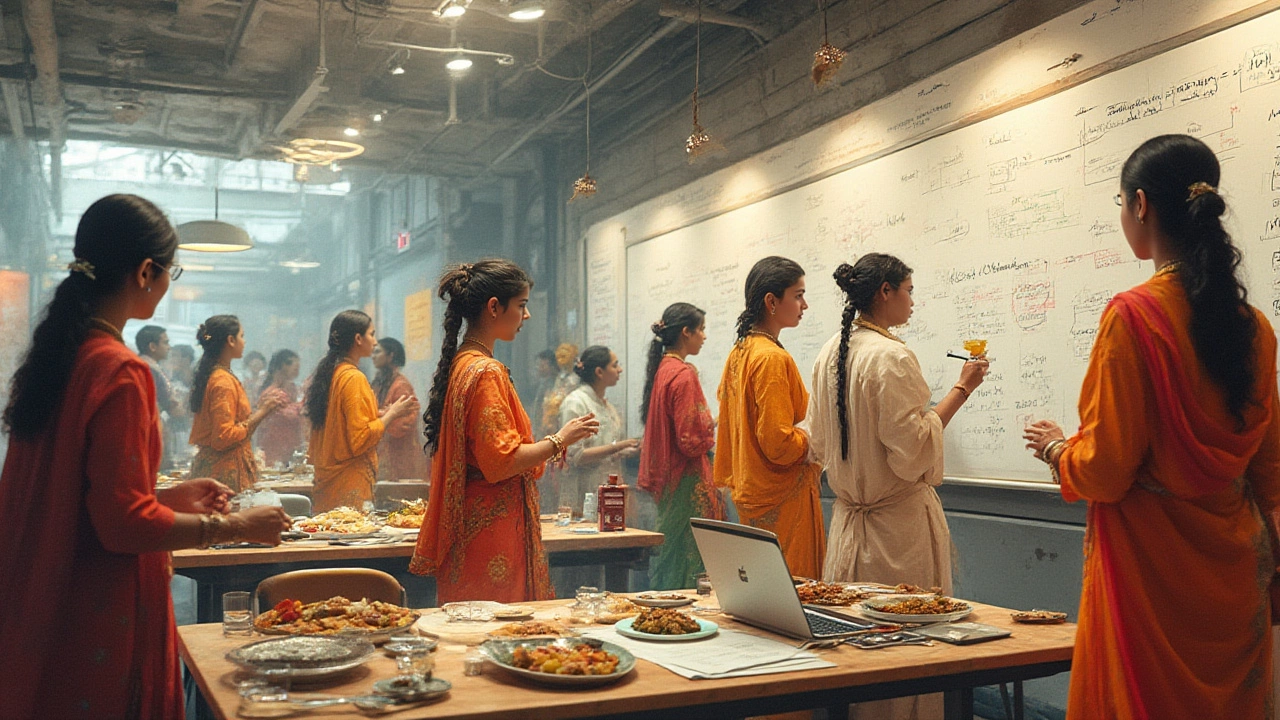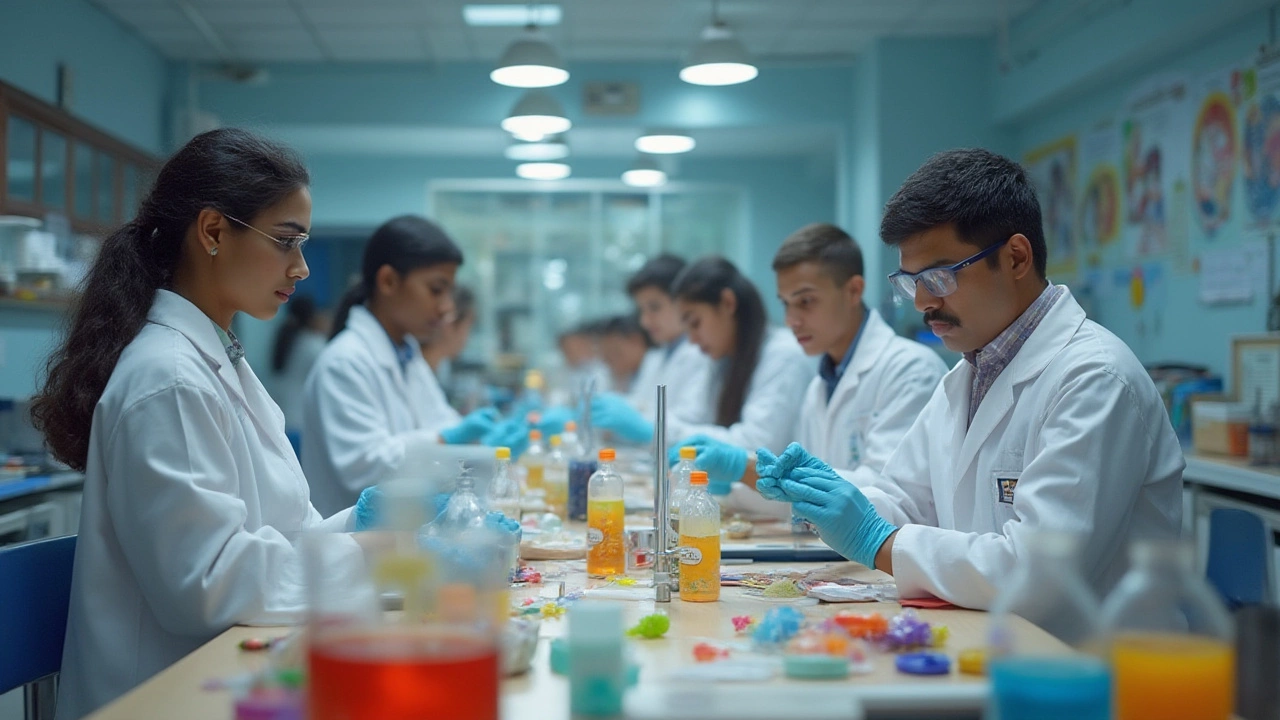Did you know that the ice cream you enjoy on a hot day started as a science experiment long before it landed in your cone? Food science isn’t just about cooking or reading nutrition labels — it’s a field where chemistry, nutrition, biology, microbiology, and engineering all crowd onto one plate. So, when people ask: “Is food science major hard?” they usually get a complicated answer. I get why you’re asking. Back in my college days, while others spent their nights cramming business case studies, my friends in food science would be sniffing milk samples under fluorescent lab lights or deciphering the weirdest chemical equations.
What Makes Food Science Challenging?
If you think majoring in food science is all about creating colorful candies or taste-testing the latest chips, let me burst that bubble. The backbone of this major is science — and not the fluffy kind. Think biochemistry, microbiology, organic chemistry, physics, and engineering principles. You’ll be diving into textbooks that don’t shy away from words like "isoenzymes" and "thermodynamics." Sure, you’ll get to cook sometimes, but most of your time will be spent trying to figure out questions like: how do we keep bacteria from turning deli meat into a science fair project, or how do we make chocolate smooth and shelf-stable at room temperature?
Let’s break it down. Expect your first two years to be full of foundational science classes that make other science majors nod in sympathy. If you struggled with high school chemistry, buckle up: Food science programs usually require two semesters of general chemistry, organic chemistry, biology, microbiology, and sometimes even calculus or statistics. Professors aren’t interested in whether you like the taste of yogurt — they want to know if you understand why the lactic acid bacteria do what they do, and how to control that during fermentation.
Labs are a huge part of this major. And they’re not easy. From the first lab, you may find yourself handling biological samples, running food safety experiments, and working with equipment that looks like it belongs in a spacecraft, not a kitchen. Mistakes in formula calculations, sterile technique, or timing can cost you more than a grade — you might spoil an experiment that takes weeks to set up. I’ve seen classmates break down over the accuracy demanded by food chemistry labs.
Group projects are another beast. Collaboration is a massive part of the degree because food science, in the real world, isn’t a solo job. You’ll develop new food products as a team, analyze flavor profiles, troubleshoot recipes, and present findings. If you dread public speaking or group meetings, these assignments will push you out of your comfort zone fast. But here's the kicker: those presentations are pretty much dry runs for future jobs in R&D or quality assurance.
Got your eye on skipping class? Good luck with the attendance policy. Because of the hands-on nature, labs and in-person sessions carry a huge weight on your grade. You really can’t phone it in. Notice how some majors are light on contact hours? Food science is not one of them. You’ll clock many hours in the lab — which means late nights, occasional accidents (a friend once spilled bacteria culture on his shoes, not pretty), and a heavy workload.
Another thing many don’t realize: the exams aren’t always about regurgitation. Critical thinking and application matter. Professors will throw you curveballs, like how would you design a snack for extreme climates, reformulate a product for allergies, or prevent mold growth in packaged bread. It’s part theoretical, part "solve real-world puzzles."
| Course Name | Typical Difficulty (1-5) | Key Skills Required |
|---|---|---|
| General Chemistry | 4 | Memorization, Application |
| Food Microbiology | 5 | Lab Technique, Analytical Skills |
| Food Engineering | 5 | Math, Problem-Solving |
| Food Chemistry | 5 | Conceptual, Laboratory Skills |
| Statistics | 3 | Analysis, Interpretation |
| Product Development | 4 | Creativity, Teamwork |
Here’s the twist: food science gets easier if you’re genuinely curious about science and food. If you like understanding why milk spoils or why gluten-free bread behaves like it does, you’ll find the “hard” parts are often the most fascinating bits. You’ll learn to read research, understand nutrition labels on a molecular level, and get a behind-the-scenes look at how every food on grocery shelves is designed, regulated, and kept safe. Which, honestly, is pretty wild.
But yes, food science is demanding — not impossible, just not a cakewalk. If you’d rather not memorize chemical structures at 2 a.m. or spend weekends troubleshooting a fermentation gone wrong, be prepared: it’s a challenge worth taking only if you’ve got grit and interest in the science that feeds us all.

Day-to-Day Reality: Coursework, Labs, and Surviving the Grind
Picture this: It’s Monday morning and you’ve barely recovered from the last week’s food microbiology lab. You’re heading into a lecture on lipid oxidation — the reason potato chips get stale. For most food science majors, each semester feels like a relay between lectures, practical labs, team projects, data analysis, and marathon study sessions. Nobody said it would be easy, but the hustle has its own rewards.
The core curriculum pushes you to develop sharp analytical skills. Expect to spend hours reviewing lab data, preparing scientific reports, and making sense of technical research. There’s a good chance you’ll use software programs to model processing lines or simulate food spoilage. For example, programs like MATLAB or Minitab aren’t just for engineers; you’ll likely run experiments and crunch data with them.
Food science courses can’t be approached the same way as most social science electives, where you skim and survive. Here, you’re tested on a blend of facts and real-world problem-solving. “Describe the enzymatic browning in apples and propose three prevention strategies?” Not a question you can answer by winging it. You’ll need to know your biochemistry, draw on case studies, and think about current industry practices.
Teamwork is front and center. Nearly every advanced course includes a product development project, where you’ll be in the “lab kitchen” formulating something new — maybe allergen-free brownies or a plant-based meat. My friend once had to source crickets for a sustainable protein snack bar project. Hardest part? Convincing people to taste-test them. But jokes aside, these projects are exactly what prepare you for the food industry, where no one works in isolation.
Time management becomes a survival skill. With overlapping assignments and tight lab bookings, procrastination isn’t really an option. Miss a step, and you risk botching not just your grade, but weeks of work for your whole group. I’ve seen more all-nighters in the food science building than anywhere else on campus — except, maybe, architecture.
One cool thing: internships count heavily, and sometimes they’re built right into the degree. Most universities encourage (sometimes require) food science students to spend a summer or semester working for food manufacturers, research labs, or even government agencies. This isn’t just coffee-fetching — you might help design improved yogurt packaging, test for foodborne pathogens, or even write up sections of an FDA submission. It’s a crash course in reality and can even lead to job offers before graduation.
Worried about burnout? You’re not alone. It's a tough schedule. But a tight-knit community forms around food science majors. Everyone’s in it together, griping about surprise quizzes or cleaning up after an oil spill in the texture analysis lab. Group chats fill with memes about “May contain traces of stress” and late-night pizza sessions break up the routine. That social bond? Lifesaver.
- Tip 1: Forming study groups early can make exam prep less of a nightmare. Trade notes, quiz each other, and someone always knows where to find last year's exam bank.
- Tip 2: Don’t neglect your writing skills. Food science isn’t just about data — it’s about explaining results and writing reports that make sense to non-scientists. Clarity counts.
- Tip 3: Stay curious. Dive into podcasts and TED Talks on food innovation; it brings the tough theory to life.
- Tip 4: Ask professors about research opportunities. Getting hands-on experience can make the course load feel less abstract and help with job prospects.
On days when you’ve run out of clean lab coats, or your latest experiment smells like burnt popcorn, remember this: nearly every aspect of modern food — from the crunch of potato chips to the shelf stability of oat milk — owes something to someone sweating through a food science lab. The real question isn’t just whether food science is hard, but whether the challenge excites you enough to stick with it.

Is Hard Worth It? Jobs, Skills, and the Payoff
Alright, the million-dollar question: why go through all this? Is the grind of the food science major justified by what comes after? Short answer: there’s good reason the field’s growing — and plenty of directions you can take.
The global food industry is massive, affecting billions every day. Food science grads step into roles designing safer, tastier, more sustainable foods, making a legit difference in how the world eats. Your degree opens doors well beyond the obvious food factories; we’re talking product development labs, quality control, supply chain management, food marketing, regulatory bodies (hello, FDA and USDA), and even startups focusing on plant-based or eco-friendly innovation. You might find yourself researching meat alternatives, developing new coffee flavors, or even tackling childhood malnutrition through fortified foods.
Let’s talk facts. According to the Bureau of Labor Statistics in the US, as of 2024, the median salary for food scientists and technologists was about $80,000 a year, and the job outlook is steady. But more important than numbers is the sheer range: jobs go from bench research (lots of lab coats) to roles in marketing and management, all demanding that you combine scientific smarts with creativity and communication.
Employers love food science grads who can handle data, solve technical problems, and aren’t afraid to get their hands dirty (sometimes literally). The best skills you’ll pick up? Problem-solving under pressure, working with cross-disciplinary teams, interpreting regulations, and communicating complex results. These are portable to lots of industries outside pure food science, too — like pharma, cosmetics, or even environmental science. Funny story from my own days: My spouse, Aarav, still jokes that no one in our family dares serve a potato salad at a barbecue unless I’ve signed off on the food safety checklist.
Lots of myths surround the profession. No, you don’t need to be a chef — though you’ll get savvier with flavors than most home cooks dream of. Yes, food science is about more than just food. You’ll spend time talking about packaging innovations, food laws, or the ethics of genetic modification. The people who thrive are the ones fascinated by the intersection of science, business, and good eating.
Here’s another fun fact: the discipline is super international. Studying food science can lead to jobs in Asia, Europe, or the US — food innovation is big everywhere. Plus, more people want foods that are not just safe, but healthy, sustainable, and even climate-friendly. Food scientists are the ones figuring out how to make plant-based proteins taste less like cardboard and how to make alternative milks foam just right for your morning latte.
Sure, there will be days you pull your hair out over a failed experiment. But if you’re curious about how everyday foods really work, if you’ve got the patience to puzzle through science that has impact, and yes, if you can handle a heavy class schedule, food science is as satisfying as it is tough. That’s what makes it worthwhile — and maybe, just maybe, a bit addictive.
Check out the stats below for a quick snapshot of what food science grads do and earn:
| Job Title | Median Salary (2024) | Typical Work Setting |
|---|---|---|
| Product Development Scientist | $82,000 | Lab, Test Kitchens |
| Quality Assurance Manager | $87,000 | Factories, Processing Plants |
| Food Safety Inspector | $75,000 | Government, Field |
| Regulatory Affairs Specialist | $78,000 | Offices, Agencies |
| Flavorist Assistant | $85,000 | R&D Labs |
Food science pushes you to think beyond the recipe. It asks you to solve tomorrow’s eating problems today. Yes, it’s tough. But if you’re up for it, it’s an adventure where every day’s lunch break is a little more interesting.






